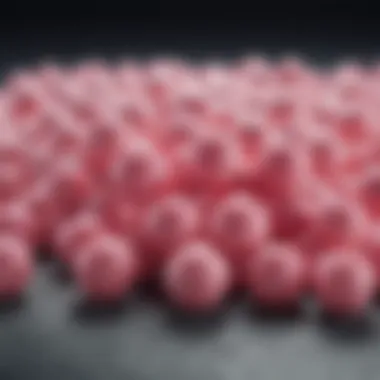The Role of Xylitol Bubble Gum in Oral Health


Intro
Xylitol bubble gum is not just a snackable delight; it has significant implications for oral health. This article will unravel its unique properties and benefits, emphasizing how the sugar alcohol xylitol acts against oral health issues. The demand for effective preventive measures in dentistry has sparked research interest in alternative sweeteners, particularly xylitol.
Research Context
Background Information
Xylitol is a naturally occurring sweetener derived from birch trees and some fruits. Its appeal is that it tastes like sugar but does not contribute to cavities. Dental health professionals often recommend xylitol because of its ability to inhibit the growth of Streptococcus mutans, which is a key contributor to tooth decay. This bubble gum contains xylitol as a primary ingredient, allowing for an easy and enjoyable way to incorporate its benefits into daily routines.
Importance of the Study
Discussion
Interpretation of Results
Research has consistently shown that regular consumption of xylitol bubble gum can lead to notable improvements in oral health. Participants in various studies reported reduced plaque formation and a lower risk of dental caries. The mechanisms behind these benefits largely stem from xylitol’s unique ability to alter the oral environment. It increases saliva flow, which helps to neutralize acids and repair early stages of tooth decay. Additionally, by displacing harmful bacteria, xylitol fosters a healthier oral microbiome.
Comparison with Previous Research
Earlier studies on chewing gum focused predominantly on sugar-based products. Research indicated that these kinds of gums could lead to dental issues due to their high sugar content. In contrast, xylitol gum represents a paradigm shift in oral health. Unlike traditional gums, which may exacerbate dental problems, xylitol-containing products are preventive. This change in focus from detrimental to beneficial ingredients reflects a growing recognition of xylitol’s role in promoting dental health.
"Xylitol bubble gum serves as a contemporary preventive tool for oral health, showcasing its effectiveness over traditional sugar-based products."
Foreword to Xylitol
Xylitol is attracting attention in the context of oral health because of its unique properties and potential benefits. Understanding its role can aid in the development of effective dental care strategies. In this section, we will explore xylitol's definition, origins, biochemical properties, and where it naturally occurs. Each of these elements contributes to our overall understanding of xylitol's significance in promoting oral health.
Definition and Origins
Xylitol is a sugar alcohol, a carbohydrate that the body metabolizes differently than standard sugars. It is found in small quantities in various plants and foods, often used as a sugar substitute. Discovered in the late 19th century, xylitol's distinct characteristics were explored further in the mid-20th century, particularly for its effects on dental health. Researchers recognized that xylitol could inhibit tooth decay, serving as an interesting alternative to traditional sweeteners.
Biochemical Properties
The biochemical properties of xylitol play an essential role in its oral health benefits. Unlike sucrose, xylitol does not ferment in the mouth. This means it does not produce the harmful acids that lead to tooth decay. Furthermore, xylitol promotes salivary flow. Increased saliva not only aids in washing away food particles, but it also helps neutralize acids produced by bacteria in the mouth. This unique interaction between xylitol and the body's chemistry is key to its protective effect against dental issues.
Natural Occurrence
Xylitol occurs naturally in various fruits and vegetables, though typically in small amounts. It is found in strawberries, plums, cauliflower, and even mushrooms. The extraction of xylitol for commercial use often involves birch trees or corn, which are processed to yield the sweet compound. This natural availability supports xylitol's appeal as a more wholesome sweetener compared to artificial options, aligning well with current trends towards natural products in dietary choices.
Understanding xylitol's origins and its biochemical nature sets a foundation for discussing its importance for oral health. As research continues to evolve, it is essential to stay updated on how xylitol can be effectively integrated into daily dental care practices.
Chewing Gum: A Historical Perspective
Chewing gum has a diverse and rich history that stretches back thousands of years. Understanding this history provides context for the modern day use of xylitol bubble gum and its benefits for oral health. Chewing gum is not merely a modern invention but a practice with cultural significance that highlights the human affinity for oral habits.
Cultural Significance
The cultural roots of chewing gum can be traced to ancient civilizations. The Mayans and Aztecs, for example, used a substance called chicle, derived from the sapodilla tree, as a form of gum. This was not only a form of sustenance but also held social and ceremonial importance. Chewing was viewed as a common cultural activity that facilitated social interactions. Historically, different cultures had their own variations of chewing gum based on local materials. Native Americans, for instance, chewed resin from tree bark, and this practice was adopted by European settlers. These early forms of gum were often associated with social customs and community bonding.
As civilizations evolved, so did the ingredients and purposes behind chewing gum. It transitioned from cultural practices to an everyday item, marketed largely for freshening breath and promoting enjoyment. Therefore, the cultural significance of chewing gum goes beyond its taste; it reflects how societies adapt and change food practices.


Evolution of Ingredients
The transition to contemporary chewing gum wasn't instantaneous. Early versions were made from natural substances, such as tree saps and waxes. However, the 19th and 20th centuries saw dramatic changes in the composition of gum. The introduction of synthetic compounds became a turning point. Ingredients like coumarin, glycerin, and various artificial flavors have become staples in many chewing gums. This development was driven by consumer demand for longer-lasting flavors and improved texture.
Xylitol bubble gum diverges from traditional formulations by featuring xylitol, a sugar alcohol known for its dental health benefits. The incorporation of xylitol demonstrates a significant shift in ingredient considerations, rooted in both health and taste. Unlike sugar, xylitol does not contribute to tooth decay, making it a favorable choice. The evolution reflects not just a change in flavors, but a growing awareness of health implications tied to oral consumption.
In summary, the historical perspective of chewing gum provides a foundation for understanding the relevance of xylitol bubble gum. The evolution of its ingredients highlights a response to consumer preferences and an increasing focus on oral health.
The Unique Attributes of Xylitol Bubble Gum
Xylitol bubble gum is distinctive, offering several advantages that set it apart from conventional chewing gum. Its unique attributes are crucial, as they influence both its popularity and its effectiveness in promoting oral health. Understanding these features is vital for appreciating why xylitol is often recommended by dental professionals.
Low Glycemic Index
One of the primary attributes of xylitol is its low glycemic index. This property indicates how a substance affects blood sugar levels after consumption. Unlike sucrose and other sugars, xylitol has a minimal impact on blood glucose levels. This characteristic makes it a suitable option for individuals managing diabetes or those who want to limit sugar intake.
Moreover, the low glycemic index of xylitol enables it to serve as a sweetener without provoking insulin spikes. This aspect is increasingly important in a health-conscious society where dietary choices are scrutinized.
Non-Cariogenic Nature
Another critical feature of xylitol bubble gum is its non-cariogenic nature. Regular sugary gum can afflict teeth by contributing to cavities. In contrast, xylitol actively inhibits the growth of Streptococcus mutans, the primary bacteria responsible for dental caries. Studies reveal that using xylitol can reduce the incidence of cavities, providing a significant advantage for those committed to their dental hygiene.
This non-cariogenic effect is essential not just for adults but particularly for children. As their dental health is still developing, choosing xylitol gum can help establish better oral hygiene habits. Incorporating xylitol into daily diets may directly influence long-term oral health, leading to fewer dental issues later in life.
"A significant body of research supports the idea that xylitol can protect against tooth decay and decrease plaque formation."
In summary, the unique attributes of xylitol bubble gum strengthen its role in oral health strategies. The low glycemic index and non-cariogenic nature illustrate its benefits not only as a sweet treat but also as an effective tool for promoting long-term dental wellness.
Oral Health Benefits of Xylitol
Xylitol has received attention in recent years, especially concerning oral health. It is not only a sugar substitute; its properties make it beneficial for dental hygiene. Understanding these benefits can aid users in choosing products that enhance their oral health.
Reduction of Dental Caries
Dental caries, commonly known as cavities, is a significant public health issue. Research indicates that xylitol can play a crucial role in reducing the incidence of dental caries. When sugar enters the mouth, it is fermented by harmful bacteria, leading to the formation of acids. This process ultimately leads to the demineralization of tooth enamel. Xylitol, however, does not undergo fermentation. Instead, it inhibits the growth of Streptococcus mutans, a primary bacterium responsible for tooth decay. Studies show that using xylitol bubble gum can decrease cavity risk by introducing an environment less conducive to these harmful bacteria. Regular consumption of xylitol, especially throughout the day, may contribute to maintaining better dental health.
Impact on Plaque Formation
Plaque formation is a sticky film of bacteria that constantly forms on teeth. If not managed properly, this plaque can lead to gingivitis, tooth decay, and other periodontal diseases. Xylitol interferes with the bacterial metabolism of sugar, which is crucial for plaque development. Some studies reveal that chewing xylitol gum can significantly reduce plaque accumulation. As the bacterial growth is hindered, individuals may experience cleaner teeth and reduced risks of gum disease. Regularly incorporating xylitol into one's oral care routine can form a vital part of plaque management, promoting better overall oral hygiene.
Salivary Flow and pH Adjustments
Chewing gum in itself can stimulate saliva production, which plays a vital role in neutralizing acids in the mouth. Xylitol takes this a step further. Studies suggest that xylitol not only encourages salivary flow but also helps maintain a balanced pH in the oral cavity. A neutral or alkaline environment is crucial for preventing tooth erosion and promoting enamel remineralization. The presence of xylitol can assist in balancing the oral ecosystem, essentially creating conditions that are favorable for teeth over time.
In summary, xylitol bubble gum contributes to significant oral health benefits by reducing dental caries, controlling plaque formation, and promoting healthy saliva production. Utilizing xylitol may improve one's dental hygiene strategies and overall oral health.
Research Findings Supporting Xylitol Use
The examination of xylitol bubble gum within oral health is underscored by a wealth of research findings. As this article explores, various studies have highlighted the effectiveness of xylitol in combatting dental issues such as caries and plaque accumulation. Understanding these research findings is essential, as they provide a scientifically grounded basis for the endorsement of xylitol as a preventive oral hygiene measure.
Clinical Trials Overview
Clinical trials play a pivotal role in assessing the practical impacts of xylitol bubble gum on oral health. Numerous studies demonstrate significant reductions in dental caries among those who frequently chew xylitol gum. For instance, a trial published in the Journal of Dental Research indicated that regular consumption of xylitol gum resulted in a 50% reduction of dental caries in children compared to those who did not use xylitol at all. These trials typically focus on controlled populations, allowing researchers to isolate xylitol's effects from other variables such as diet or overall oral hygiene practices.


Some key points from these trials are:
- Duration of Gum Chewing: Many studies recommend chewing xylitol gum for at least 5 minutes after meals for optimum results.
- Frequency: The ideal frequency is often 2-4 times per day for significant benefits.
- Age Groups: While xylitol benefits all age groups, studies show especially promising results in children.
Ensuring rigorous methodologies in these clinical trials bolsters the credibility of xylitol as a dental health ally. It remains necessary for ongoing research to refine these findings and evaluate long-term benefits.
Meta-Analyses and Systematic Reviews
In addition to individual studies, meta-analyses and systematic reviews further validate the oral health benefits of xylitol. These comprehensive approaches aggregate data from multiple trials, providing a broader view of xylitol’s efficacy. One such meta-analysis highlighted in Caries Research synthesized results from over 30 studies, confirming that xylitol can significantly lower the incidence of caries in both children and adults.
The analysis revealed some trends:
- Comparison with Other Sweeteners: Xylitol performs better than traditional sweeteners, showcasing its non-cariogenic nature.
- Health Recommendations: The reviews recommend incorporating xylitol as a part of daily oral hygiene, alongside regular brushing and flossing.
- Types of Products: Not only gum but also xylitol-infused mints show comparable effectiveness in caries reduction.
"The evidence supporting xylitol usage paints a clear picture: it can significantly improve oral health and reduce the risk of cavities when used as part of a comprehensive oral hygiene strategy."
Consumer Preferences and Market Trends
Understanding consumer preferences and market trends regarding xylitol bubble gum is vital in discussing its impact on oral health. In recent years, there has been a noticeable shift towards more health-conscious products, and xylitol bubble gum has emerged as a prominent contender in this category. This growing interest reflects greater awareness among consumers about the importance of oral hygiene and the potential preventive benefits of specific ingredients, such as xylitol. Consumers are increasingly seeking products that not only freshen breath but also contribute positively to dental health.
Popularity Among Health-Conscious Consumers
Health-conscious consumers prioritize products that offer tangible benefits. Xylitol bubble gum satisfies this need by presenting itself as a sugar-free alternative that does not contribute to cavities. In a market flooded with sweets and conventional chewing gums, the unique properties of xylitol—such as its ability to stimulate saliva production—set it apart. The gum appeals particularly to those informed about dental health, including parents looking for safer snack options for their children. Studies suggest that when people understand the roles ingredients play in preventing tooth decay, they are more likely to choose products like xylitol gum.
Some factors driving this popularity include:
- Health education: Increased focus on the role of diet in oral health fosters more informed consumer choices.
- Product labeling: Clear information on health benefits on packaging allows consumers to make educated decisions.
- Social media influence: Platforms where health trends are discussed educate users on the benefits of xylitol and related products.
Product Varieties in the Market
The market for xylitol bubble gum is expanding, encouraging manufacturers to innovate and diversify their offerings. Diverse formulations cater to varying consumer preferences. Some popular varieties include:
- Flavor diversity: Manufacturers offer a range of flavors, from mint to fruity options, making the product appealing to a broader audience.
- Functional gum: Some products not only contain xylitol but also include added ingredients for enhanced oral health, like enzymes or probiotics.
- Sugar-free certification: Many xylitol gums display certifications which reassure consumers about their quality.
In addition, the rise of e-commerce has facilitated easier access to these products, allowing consumers to shop based on their specific preferences and needs. Retailers have begun to develop dedicated sections for health-oriented products, ensuring xylitol bubble gum is prominently positioned in stores.
"As consumer awareness grows, the demand for products that align with health goals is reshaping market trends in the oral care segment."
Challenges and Limitations
Understanding the challenges and limitations of xylitol bubble gum is essential when evaluating its role in oral health. While there are numerous advantages linked to xylitol, it's important to also recognize potential drawbacks or issues surrounding its use. This segment will discuss side effects associated with xylitol gum and factors impacting its accessibility and affordability.
Potential Side Effects
Xylitol is often touted for its benefits, particularly in reducing the risk of dental caries. However, some users report gastrointestinal discomfort when consuming xylitol products. This is primarily due to its sugar alcohol nature. Consuming large amounts of xylitol at once may result in symptoms such as bloating, gas, or even diarrhea. It's generally advised to introduce xylitol gradually into the diet to minimize these risks.
Additionally, individuals allergic to xylitol should avoid its use completely. While this condition is rare, it serves as a reminder that individual responses to food ingredients can vary widely.
Accessibility and Cost Factors
Accessibility to xylitol bubble gum can vary based on location and market availability. In some regions, traditional sugary gums may be more prevalent than their xylitol counterparts. Consequently, consumers may struggle to find xylitol options. This discrepancy can be particularly significant in areas with limited health food or specialty stores.


Moreover, the cost of xylitol products can be higher than standard chewing gums. Factors influencing pricing include production costs, distribution, and if the gum is marketed as a health product. This can pose a barrier for those on a budget, restricting their options for purchasing xylitol gum regularly.
Practical Applications in Dental Care
The integration of xylitol bubble gum into dental care practices presents significant potential for enhancing oral health. Its use extends beyond mere enjoyment; it serves as a practical tool for preventive care. Recognizing the specific benefits of xylitol is essential for individuals aiming to improve their oral hygiene.
Integration into Daily Oral Hygiene Routines
Incorporating xylitol bubble gum into daily oral hygiene routines is relatively straightforward. Here are some practical tips:
- Timing: Chewing xylitol gum after meals can help mitigate the acid production from bacteria in the mouth. This practice can be especially beneficial in environments where brushing teeth may not be instantly possible.
- Duration: Chewing for at least 5 to 10 minutes can maximize its effect on salivary flow, which aids in neutralizing acidity and washing away food particles.
- Frequency: Daily consumption should be encouraged, ideally after each meal or snacks. This frequent use helps maintain a consistent level of xylitol in the oral environment.
These strategies not only improve the efficacy of xylitol but also help in establishing consistent oral hygiene habits. The habitual use of xylitol gum can contribute to a healthier mouth and reduce the risk of cavities.
Recommendations from Dental Professionals
Dental professionals increasingly recognize the value of xylitol in promoting oral health. Many recommend it for several reasons:
- Evidence-Based Advice: Numerous studies highlight xylitol's effectiveness in reducing dental caries rates. Dentists often suggest xylitol to patients susceptible to cavities or those with a history of dental issues.
- Alternative to Sugar: As xylitol is non-cariogenic, it is presented as a preferable alternative to traditional sugary gums. Dental experts advocate for its use in combatting the negative effects of sugar on oral health.
- Educational Outreach: Professionals are taking steps in clinics and outreach programs to educate patients about the benefits of xylitol. This effort is part of a broader initiative to promote preventive dental care.
"Integrating xylitol into one’s daily regime can fundamentally alter oral health outcomes. It works to create a more balanced environment in the mouth, which is crucial for maintaining health over time."
In summary, the incorporation of xylitol bubble gum into daily routines accompanied by professional recommendations reinforces its role as an effective preventive measure. The synergy of better hygiene practices with informed professional suggestions can lead to improved oral health outcomes.
Future Directions of Research
The future of research on xylitol bubble gum holds significant promise for enhancing our understanding of oral health interventions. Current findings provide a solid foundation, yet complex aspects of xylitol’s benefits warrant further exploration. The focus lies not just on its existing applications but also on innovative approaches that can expand its use in preventive oral care. Studies aiming to uncover the full range of xylitol's effects will likely lead to new products and guidelines that dental professionals can utilize effectively.
Emerging Trends in Oral Health
As public awareness of oral health increases, so does the interest in substances like xylitol. One notable trend is the growing consumer demand for more natural and effective oral hygiene products. Many consumers are shifting from traditional sugars used in gums to alternatives like xylitol. This shift suggests that future research should examine consumers’ preferences and how these preferences influence market trends.
In addition, digital health technology is becoming more intertwined with oral health. Developments in app-based oral hygiene reminders and tracking tools can incorporate xylitol recommendations, promoting its consistent use. Researchers should study the efficacy of these tools combined with the benefits of xylitol chewing gum. Moreover, an investigation into the psychological aspects, such as how taste and sweetness perception influence consumer choices, could provide valuable insights into marketing and product development.
Innovations in Xylitol Formulations
Innovations in product formulations can significantly enhance the effectiveness of xylitol. Researchers are exploring various delivery methods that could increase xylitol's efficacy. For example, the development of xylitol-infused dental products such as mouth rinses and toothpaste are gaining traction. Such products can complement the benefits offered by bubble gums, leading to broader acceptance and usage.
Furthermore, studies might focus on combining xylitol with other beneficial components. Ingredients like probiotics could create synergistic effects that enhance oral microbiome health. Products that target specific populations, such as children or individuals with braces, may also prove valuable.
Overall, the future directions of research into xylitol bubble gum and its role in oral health are multi-faceted. The focus on consumer behavior, technology integration, and formulation innovations is set to shape the landscape of oral health products. As these studies unfold, they will likely lead to practical applications that affect dental practices and consumer habits significantly.
The End
The exploration of xylitol bubble gum's impact on oral health reveals significant advantages worth considering. Effective in reducing dental caries and plaque formation, it presents itself as a compelling addition to oral hygiene practices. This conclusion synthesizes the findings discussed throughout the article, emphasizing not only the direct benefits of xylitol but also its implications in broader public health contexts.
Summary of Findings
Xylitol bubble gum serves as an effective intervention in augmenting oral health. Studies indicate:
- A reduction in the levels of Streptococcus mutans, the primary bacteria responsible for tooth decay.
- Enhanced salivary flow, which aids in neutralizing acids and washing away food particles.
- A favorable impact on the pH balance in the mouth, promoting an environment less conducive to decay.
These findings underscore the potential of incorporating xylitol into daily oral hygiene routines. As awareness of its benefits spreads, xylitol gum can serve as a proactive measure, supporting efforts to maintain optimal oral health.
Implications for Public Health
The implications of using xylitol bubble gum extend beyond individual oral care to encompass broader public health perspectives. Its non-cariogenic nature positions it as a viable alternative to traditional sugary gums that contribute to dental issues. Furthermore:
- Encouraging xylitol usage, especially among children, may help curb the prevalence of dental caries in younger populations.
- Increased public awareness of xylitol's benefits can drive more families to adopt healthier oral habits.
- Reducing the incidence of dental caries could lower overall healthcare costs, highlighting a tangible benefit for healthcare systems and insurers.















